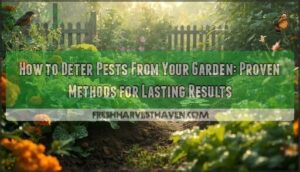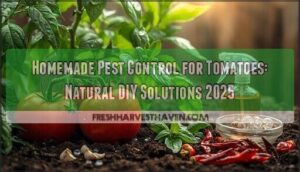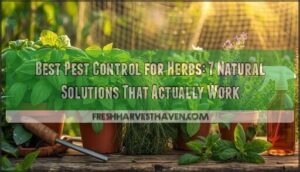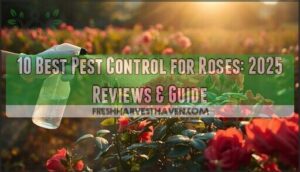This site is supported by our readers. We may earn a commission, at no cost to you, if you purchase through links.
Gardeners everywhere know the feeling: one day your greens are thriving, the next, leaves are riddled with holes, stems look gnawed, and new shoots vanish overnight. Pests don’t just damage what you see—they can unravel weeks of careful work before you realize what’s happening.
Learning how to deter pests from your garden isn’t about harsh chemicals or endless frustration; it’s about building a system where nature has your back. When you understand which garden invaders to expect and how natural defenses stack up, you’ll give your plants the best shot at staying healthy all season.
Table Of Contents
- Key Takeaways
- How to Deter Pests From Your Garden
- Install Physical Barriers and Mechanical Controls
- Grow Pest-Repelling and Companion Plants
- Encourage Beneficial Wildlife and Insect Predators
- Maintain a Healthy, Pest-Resistant Garden
- Frequently Asked Questions (FAQs)
- How do you keep pests away from vegetable plants?
- Do garden pests wreak havoc on your plants?
- How do I get rid of pests in my garden?
- How do I get rid of pests naturally?
- How do I keep mosquitoes out of my Garden?
- How can I reduce pest pressure in my garden?
- What time of day is best for pest control?
- How do weather conditions affect pest activity?
- Can homemade sprays harm beneficial insects too?
- How often should I inspect my garden for pests?
- Conclusion
Key Takeaways
- Building soil health, choosing pest-resistant plants, and practicing good garden hygiene are your best defenses against infestations.
- Physical barriers like row covers, copper tape, and diatomaceous earth effectively block and repel common pests without relying on chemicals.
- Companion planting and using pest-repellent herbs or trap crops naturally deter invaders while supporting overall garden balance.
- Attracting birds and beneficial insects, plus avoiding broad-spectrum pesticides, creates an ecosystem where nature helps manage pests for you.
How to Deter Pests From Your Garden
Keeping unwanted pests out of your garden doesn’t need to be complicated or harsh. There are several effective options you can use to protect what you grow.
Here’s a look at some proven ways to keep invaders at bay.
Common Garden Pests to Watch For
Trouble in the garden often wears many faces. Three top culprits keep growers on their toes:
- Aphid infestations can explode overnight, damaging leaves and spreading disease.
- Slug damage leaves unsightly holes and devours tender shoots under damp conditions.
- Mite problems and beetle concerns cause leaf yellowing, scarring, and stunted growth, complicating efforts to keep your plants thriving. A common issue is a mealy bug infestation that can affect plants like brussels sprouts.
Why Natural Pest Control Works
Natural pest control methods succeed for a reason: they’re rooted in nature’s wisdom and promote ecosystem health. Modern effectiveness rivals chemicals, supporting beneficial insects and long-term balance. These approaches curb resistance development, protect the environment, and fit seamlessly into organic gardening.
Natural pest control works by harnessing nature’s balance, offering powerful, eco-friendly solutions that support both your garden and the planet
As adoption trends rise, strategies like companion planting build stronger defenses while keeping your garden safer for people, pollinators, and the planet. Organic methods often use natural pest ingredients.
Key Principles for Preventing Infestations
Organic gardening thrives on more than luck; it’s about stacking the deck in your favor. Keep your garden resilient with three pillars:
- Build healthy soil for strong roots and vigorous growth.
- Choose pest-resistant varieties and rotate crops year to year.
- Prioritize garden hygiene and early detection—catching small problems before they explode makes pest prevention manageable.
Install Physical Barriers and Mechanical Controls
Some of the simplest ways to keep pests out start with smart barriers. These solutions block troublemakers before they can do any real damage.
Here’s what you can put in place to protect your plants.
Using Row Covers and Fine Mesh Netting
Think of row covers and fine mesh netting as your garden’s custom armor—designed for the job. With materials like spun-bonded polyester or polypropylene, these barriers block aphids, flea beetles, and cabbage butterflies.
Install covers snug against the soil, ensuring at least a six-inch overlap. They shield crops and boost yield, and they slash the need for pesticides and protect pollinators.
Applying Copper Tape for Slugs and Snails
For slugs and snails, copper tape provides a precise mechanical shield: its unique tape mechanism repels through mild electrical stimulation.
Coverage matters—barrier dimensions of at least 3 inches wide work best. Achieve results with proper installation: wrap clean, continuous rings around pots or beds.
Be aware, performance limits exist, and maintenance needs—like cleaning oxidation—are key for lasting pest defense.
Using Diatomaceous Earth and Mulch
When you need an effective pest barrier, combine diatomaceous earth (DE) application with mulch for an integrated approach.
Lay a thin layer of DE over or around mulch types you use—this targets crawling pests, while mulch itself boosts soil health and retains moisture.
Together, these pest control methods limit weeds and pests without sacrificing your garden’s resilience or safety.
DIY Traps and Fruit Protection Methods
Among low-impact pest control tools, hands-on methods shine. For instance:
- Bottle trap efficacy is high for flying bugs—DIY yeast and sugar traps lure them in.
- Proper sticky trap placement around garden beds intercepts whiteflies and aphids.
- Beer trap alternatives and organza bag usage protect fruit trees; bagging fruit benefits include keeping pests and birds at bay—all boost natural pest control.
Grow Pest-Repelling and Companion Plants
If you want fewer pests nibbling on your plants, the right mix of flowers and herbs can give you a real edge. Certain plant pairings work together to keep bugs at bay, naturally.
Here are some of the best ways to use companion plants for extra protection.
Best Plants for Natural Pest Deterrence
You want your garden’s frontline defense? Start with pest-repelling plants. Marigolds aren’t just for looks—they stunt nematodes and repel insects. Lemongrass helps keep mosquitoes away, while mint confuses whiteflies and aphids. Garlic deters aphids naturally, and chrysanthemums supply pyrethrum—a direct hit for crawling pests.
Smart gardeners weave these pest deterrents into every patch for natural pest control.
Companion Planting Strategies
Think of your garden as an ecosystem orchestra—companion planting strategies let you conduct a symphony of protection and productivity. By using companion plants and intercropping techniques, you confuse and disrupt pests, boost soil enrichment, and tap into the Polyculture Benefits aromatics offer.
Implementing companion planting weaves in Aromatic Repellents, natural defenses, and resilience, which monocultures simply can’t match.
Using Decoy and Trap Crops
Imagine sending pests on a wild goose chase—trap crops like nasturtiums or marigolds work as decoys, drawing invaders away from your main harvest.
By smartly weaving trap crop allocation into your companion planting, you boost pest reduction and increase yields.
Careful implementation practices turn these species into reliable economic allies, proving that nature’s teamwork beats chemical dependency.
Encourage Beneficial Wildlife and Insect Predators
Letting nature lend a hand can make all the difference in keeping your garden healthy. By welcoming helpful wildlife and insect predators, you’ll create balance and keep pests in check.
Here are some effective ways to encourage these natural allies.
Attracting Birds, Ladybugs, and Lacewings
Curious how to put nature’s best workers on your side? Smart birdhouse placement and water sources draw in birds that gobble up pests daily.
Ladybug habitats—especially near aphid-prone plants—multiply your defense, while scattering lacewing eggs boosts your pest patrol.
Attracting natural predators like ladybugs and lacewings transforms your garden into a living fortress of beneficial insects.
Creating Habitats for Natural Predators
Once you’ve drawn in beneficial insects and birds, give them every reason to stick around. Native plantings, wild zones, and thoughtfully placed habitat features create natural corridors where pest predators can thrive.
Adding water sources or brush piles offers vital shelter. The key is variety—guarantee connectivity and scale so natural predators and beneficial insects can patrol, nest, and multiply season after season.
Avoiding Broad-Spectrum Pesticides
Steering clear of broad-spectrum pesticides doesn’t just protect those hardworking birds and insects you’ve welcomed into your garden—it pays off for your soil, your food, and your peace of mind.
Insecticide alternatives and natural remedies keep soil biodiversity thriving, slow resistance development, and reduce risks to human health.
Embrace chemical-free, organic pest control for resilient, balanced pest management with ecosystem benefits.
Maintain a Healthy, Pest-Resistant Garden
Keeping your garden healthy does most of the heavy lifting for pest resistance. There are a handful of time-tested habits you can count on to make pests less of a problem.
Here’s what to focus on next.
Improving Soil Health and PH Balance
Set your garden up for resilience by improving soil health and pH balance—the foundation that keeps pests in check. Healthy soil thrives on microbial diversity, regular soil testing, and smart use of organic amendments.
Need to keep plants vigorous and resistant? Prioritize:
- Soil pH monitoring and correction
- Adding compost or organic amendments
- Balancing nitrogen management for long-term pest resistance
Practicing Crop Rotation and Garden Hygiene
If you want lasting pest control, make crop rotation and garden hygiene part of your regular routine. Swapping plant families each season disrupts pest and disease cycles, reduces chemical needs, and boosts soil health.
Pairing crop rotation benefits with the hygiene impact of removing debris means fewer outbreaks. Garden maintenance isn’t glamorous, but it’s absolutely essential for preventing pest infestations and optimizing strategies year after year.
Regular Monitoring and Early Intervention
While you might hope pests leave your garden alone, consistent scouting frequency—at least twice weekly—tips the odds in your favor. With early infestation detection, swift action means fewer headaches and lower costs.
Track what you see; data documentation reveals patterns over time. Public surveillance and daily attention aren’t just busywork—they lead to better economic outcomes and a healthier, resilient garden.
Applying Organic Sprays and Natural Repellents
With garden care, using organic sprays and natural repellents offers a practical, targeted approach to natural pest control. Mind your dosage concerns—overapplying can harm beneficial bugs and your plants. For best results, focus on:
- Proper spray application techniques
- Biopesticide efficacy (Bt, spinosad)
- Evaluating environmental impact
- Favoring safe, homemade pest control sprays
- Prioritizing organic pest control methods
Frequently Asked Questions (FAQs)
How do you keep pests away from vegetable plants?
Imagine your prized tomatoes under siege—nature always tests your resolve.
By focusing on early detection, plant defenses like companion planting, pest identification, garden sanitation, and organic solutions, you’ll keep pests at bay in your vegetable garden.
Do garden pests wreak havoc on your plants?
Yes, garden pests can wreak havoc—feeding on leaves, stunting growth, and transmitting diseases. Quick pest identification and damage assessment help you gauge infestation severity and economic impact, guiding effective, natural pest control strategies, especially as climate effects increase risks.
How do I get rid of pests in my garden?
If your plants look like they’ve survived a stampede, it’s time for pest identification and early detection.
Lean on natural solutions first—row covers, companion planting, organic pesticides, and rigorous garden hygiene all weave strong, lasting pest control methods.
How do I get rid of pests naturally?
Kickstart natural pest removal with organic pest control techniques like homemade pest solutions, eco-friendly pesticides, and safe pest management.
Companion planting and attracting beneficial insects support organic gardening, while thoughtful pest deterrents keep your crops thriving, pesticide-free.
How do I keep mosquitoes out of my Garden?
An ounce of prevention is worth a pound of cure—start by eliminating standing water to break mosquito breeding cycles, plant insect repellent vegetation for minor impact, and use natural repellents or targeted traps to boost your mosquito control effectiveness.
How can I reduce pest pressure in my garden?
Maintain healthy soil, use wider plant spacing, and prune regularly to boost immunity, while proper watering practices keep stress low.
Remove infested material to cut pest hotspots—these natural pest control strategies are key to preventing garden pests.
What time of day is best for pest control?
Think of early morning or evening as your secret weapons for pest control—cooler temps mean slower evaporation, higher humidity, and less wind.
That’s when pesticide effectiveness peaks and the risk to beneficial insects and your garden’s environment drops.
How do weather conditions affect pest activity?
Temperature impacts how quickly pests breed; warm spells and mild winters fuel rapid infestations.
Rainfall effects differ—heavy rains spark slug and mosquito surges, while humidity influence and climate extremes like drought or flood reshape pest damage and seasonal variability.
Can homemade sprays harm beneficial insects too?
Ever wondered if your DIY bug spray could backfire? Even natural pest control methods—think garlic or soap sprays—can cause larval mortality in beneficial insects.
Spray toxicity and pollinator exposure risks highlight research gaps in organic gardening insecticide safety.
How often should I inspect my garden for pests?
Inspect your garden for pests at least twice a week during the growing season, especially after rain or temperature changes.
Frequent checks and good record-keeping catch issues early, which makes managing garden pests and preventing infestation much more effective.
Conclusion
What would your garden look like if pests weren’t calling the shots? Knowing how to deter pests gives you a powerful edge—shielding each seedling, nurturing every harvest, and letting nature’s own checks and balances do the heavy lifting.
With practical barriers, smart planting, and keen observation, you shift from reacting to prevention. Your garden becomes less a buffet for invaders, more a sanctuary where your effort, not insects, decides what flourishes.
- https://vtpp.ento.vt.edu/content/dam/vtpp_ento_vt_edu/publications/ReducingPesticideUseInTheHomeLawn_Garden.pdf
- https://extension.arizona.edu/sites/default/files/2024-08/az1521.pdf
- https://content.ces.ncsu.edu/extension-gardener-handbook/8-integrated-pest-management-ipm
- https://ipm.missouri.edu/MEG/2017/3/Trap_cropping/
- https://pmc.ncbi.nlm.nih.gov/articles/PMC6780270/











